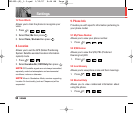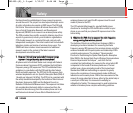
66 VX340066 VX3400
Safety
that has driven the establishment of new research programs
around the world. The project has also helped develop a series
of public information documents on EMF issues. The FDA and
the Cellular Telecommunications & Internet Association (CTIA)
have a formal Cooperative Research and Development
Agreement (CRADA) to do research on wireless phone safety.
The FDA provides the scientific oversight, obtaining input from
experts in government, industry, and academic organizations.
CTIA-funded research is conducted through contracts with
independent investigators. The initial research will include both
laboratory studies and studies of wireless phone users. The
CRADA will also include a broad assessment of additional
research needs in the context of the latest research
developments around the world.
77.. HHooww ccaann II ffiinndd oouutt hhooww mmuucchh rraaddiioo ffrreeqquueennccyy eenneerrggyy
eexxppoossuurree II ccaann ggeett bbyy uussiinngg mmyy wwiirreelleessss pphhoonne
e??
All phones sold in the United States must comply with Federal
Communications Commission (FCC) guidelines that limit Radio
Frequency energy (RF) exposures. The FCC established these
guidelines in consultation with the FDA and the other federal
health and safety agencies. The FCC limit for RF exposure from
wireless telephones is set at a Specific Absorption Rate (SAR) of
1.6 watts per kilogram (1.6 W/kg). The FCC limit is consistent with
the safety standards developed by the Institute of Electrical and
Electronic Engineering (IEEE) and the National Council on
Radiation Protection and Measurement. The exposure limit takes
into consideration the body’s ability to remove heat from the
tissues that absorb energy from the wireless phone and is set
well below levels known to have effects. Manufacturers of
wireless phones must report the RF exposure level for each
model of phone to the FCC.
The FCC website (http://www.fcc. gov/oet/rfsafety) gives
directions for locating the FCC identification number on your
phone so you can find your phone’s RF exposure level in the
online listing.
88.. WWhhaatt hhaass tthhee FFDDAA ddoonnee ttoo mmeeaassuurree tthhee rraaddiioo ffrreeqquueennccyy
eenneerrggyy ccoommiinngg ffrroomm wwiirreelleessss pphhoonneess??
The Institute of Electrical and Electronic Engineers (IEEE) is
developing a technical standard for measuring the Radio
Frequency energy (RF) exposure from wireless phones and other
wireless handsets with the participation and leadership of FDA
scientists and engineers. The standard, “Recommended
Practice for Determining the Spatial-Peak Specific Absorption
Rate (SAR) in the Human Body Due to Wireless Communications
Devices: Experimental Techniques”, sets forth the first
consistent test methodology for measuring the rate at which RF
is deposited in the heads of wireless phone users. The test
method uses a tissue-simulating model of the human head.
Standardized SAR test methodology is expected to greatly
improve the consistency of measurements made at different
laboratories on the same phone. SAR is the measurement of the
amount of energy absorbed in tissue, either by the whole body or
a small part of the body. It is measured in watts/kg (or
milliwatts/g) of matter. This measurement is used to determine
whether a wireless phone complies with safety guidelines.
VX3400-(E)_1.3.qxd 1/12/07 8:44 AM Page 66


















